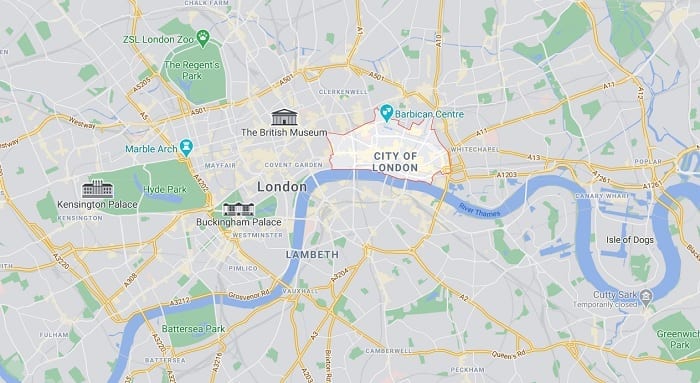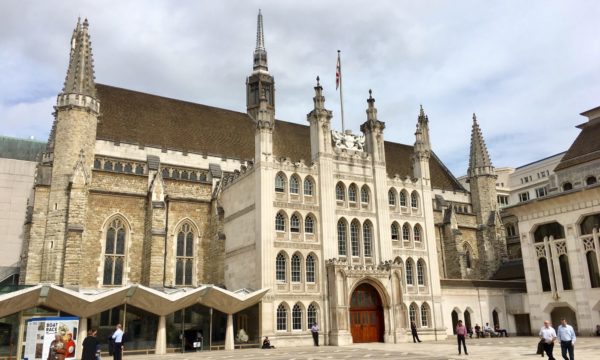This post provides details about the differences between the actual City of London and the surrounding area known as Greater London.
When tourists visit London, they tend to think of the entire area as one city, but that’s technically not the case. Let's get some knowledge!
WHAT IS THE CITY OF LONDON?
The real City of London is located at the centre of Greater London, and it comprises around 2 square miles of space with only around 10,000 residents.
Despite the relatively small number of people living there and the limited space, the city welcomes around 400,000 commuters every day who work in all the buildings you’ll find here, many of which we’ll cover below.
The City of London is essentially the same area that was once known as Londinium during the Roman era.
There are ruins and artefacts on display in many different locations, and we cover some of them in our post on Roman London Ruins.
A total of 10 million tourists visit this city every year, which ensures that it remains a thriving and popular location to visit while you’re in London.
We also offer daily tours of the City of London, both guided tours and GPS audio tours. Learn more here.
WHERE IS THE CITY OF LONDON?
If you’re wondering how to tell whether or not you’re in the City of London, there are a few different ways to find out which we cover in the list of differences below.

You can also use this map or Google Maps to see the boundaries of this city and figure out whether or not you’re actually within city limits.
Here are a few things you can look for to help determine if you’re actually in the City of London.
Dragon Boundary Marks
You’ll know you’re in the real City of London when you pass by one of these large dragon statues.
There are a total of 13 Dragons that delineate the boundaries of the city.

Each dragon is made out of cast iron and painted silver with touches of red on their wings and tongue.
The shield they bear is the City of London’s coat of arms.
NOTE: If you're interested in learning more about the history of this mythic creature and its relation to London, consider taking this City of Dragons walking tour!
Street Signs
This is another easy way to figure out if you’re in the actual City of London or the Greater London area.
The street signs in the city itself all have both the coat of arms and they specifically state they are in the “City of London,” while signs outside of this area will say “City of Westminster” or the name of another city or district.

To be honest, while it’s interesting that they have statues of lions at the borders of the city, this is most likely going to be the easiest method to determine whether or not you’re in the right location.
And no, it's not named after him 🙂
Street Poles
As you walk down the sidewalks of the City of London, you might see a few poles lining the road.
If you look closer, you’ll find they are marked with the name and coat of arms for the city, making this another easy way to tell if you’re in the right place.
What Makes the City of London Special?
There are some key differences between the City of London and the area surrounding it, Greater London.
This section details some of the distinctions that make this city so unique.
Flag of the City of London
Based on the flag of England, this design features the red cross of St. George on a white background with a red sword on the upper left.
You may notice, this is the same design as the coat of arms for the city.

It is commonly held that the sword is representative of the sword used to behead St. Paul, the patron saint of the City of London.
One of the most interesting things about this sword is that they never allow it to point anywhere but upward.
So, there are actually special flags created for hanging as a banner that keeps the sword in the same position at the upper left of the flag.
Lord Mayor of London
Also known as The Right Honourable Lord Mayor of London, this title differs from others in England, as does the political power of the person who holds the title.
The City of London has its own government which is partially separate from that of Greater London, and the Lord Mayor is the head figure of that government.
Every November, there is a special event known as the Lord Mayor’s Show takes place in which he rides through a parade in the carriage.
The Square Mile
The City of London is also known as the Square Mile due to its history.
Originally, the area was once a Roman settlement called Londinium, and it encompassed roughly one square mile - hence the name.
Surprisingly, the city is actually now around 2 square miles in size, but sometimes a good nickname manages to last longer than its original meaning.
Police & Firefighters
The police and fire companies here are under the jurisdiction of the City of London rather than Greater London, and there are a total of 3 police stations and one fire station.
Due to the relatively small size of the precinct, this is technically the smallest police force in all of England.
Different Taxes
Since the City of London has its own separate government, it also collects its own taxes which are different from those collected in the Greater London area.
As such, anyone living in this city can expect to pay taxes to this local government rather than the rest of the city.
NOTABLE SIGHTS
This section will provide information about some of the most popular locations to visit while you’re in the City of London.
Since it’s in the city centre, you will probably notice a lot of familiar landmarks on this list!
The Mansion House
This is the official residence of the Lord Mayor of London, and it is also used for a few official functions such as white tie dinners and speeches.
Built between 1739-1752, this location was designed in the Palladian style of architecture.
Sadly, the residence is not usually open to the public, but they do offer public tours on most Tuesdays at 2 pm.
These tours cover the 18th-century rooms and Harold Samuel Collection.
Prices start at £9.50 for general admission and £7.50 for concession tickets.
A max of only 40 people are allowed on these tours, so you may want to book your tour well in advance.
The London Bridge & Tower of London
These famous and popular historic sites are actually owned by the City of London rather than the London Government, and they are of course part of the city.
The jurisdiction of this city stretches from the Tower of London to Liverpool Street in the east and Chancery Lane in the west.
So you know the differences between these two bridges?
The Guildhall
While this location is usually known as the City Hall in most cities, here it is called the Guildhall.

This is where the Right Honourable Lord Mayor of London goes to work each day.
During Roman times, this was actually the site of the largest amphitheatre in Britannia, and they actually have some remains of this original building on public display in the Guildhall Art Gallery.
The Gherkin
One of the most notable (and newest) landmarks in the City of London is 30 St. Mary Axe.
Even before opening in 2004, the Neo-Futuristic architectural style of the building prompted residents to give it a nickname: The Gherkin.

Why this name? Well, if you look at it just right, it looks a bit like a pickle.
Due to its towering frame, this is one of the best viewing locations in all of London.
The Walkie-Talkie
This is yet another unique Neo-Futuristic building in the City of London, and much like the Gherkin, locals have given it a distinctive name related to its shape.
Once again, if you look at this building from a certain perspective, it certainly seems to resemble a large walkie-talkie, or perhaps even an old cellphone.
You’ll find this landmark at 20 Fenchurch Street. For more details, read our post about the Walkie-Talkie.
The Cheesegrater
Starting to notice a trend? The people of London really like to give proper nicknames to their buildings.
Otherwise known as the Leadenhall Building, this tall structure has the appearance of a traditional cheesegrater.
When seen from afar, the use of straight lines and triangular shapes certainly conjures up images of the kitchen utensil.











